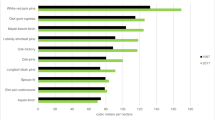Abstract
Stimulation of terrestrial productivity by rising CO~2~ concentration is projected to reduce the airborne fraction of anthropogenic CO~2~ emissions; coupled climate-carbon (C) cycle models, including those used in the IPCC Fourth Assessment Report (AR4), are sensitive to this negative feedback on atmospheric CO~2~^1^. The representation of the so-called CO~2~ fertilization effect in the 11 models used in AR4 and subsequent models^2,3^ was broadly consistent with experimental evidence from four free-air CO~2~ enrichment (FACE) experiments, which indicated that net primary productivity (NPP) of forests was increased by 23 +/- 2% in response to atmospheric CO~2~ enrichment to 550 ppm^4^. Substantial uncertainty remains, however, because of the expectation that feedbacks through the nitrogen (N) cycle will reduce the CO~2~ stimulation of NPP^5,6^; these feedbacks were not included in the AR4 models and heretofore have not been confirmed by experiments in forests^7^. Here, we provide new evidence from a FACE experiment in a deciduous Liquidambar styraciflua (sweetgum) forest stand in Tennessee, USA, that N limitation has significantly reduced the stimulation of NPP by elevated atmospheric CO~2~ concentration (eCO~2~). Isotopic evidence and N budget analysis support the premise that N availability in this forest ecosystem has been declining over time, and declining faster in eCO~2~. Model analyses and evidence from leaf- and stand-level observations provide mechanistic evidence that declining N availability constrained the tree response to eCO2. These results provide a strong rationale and process understanding for incorporating N limitation and N feedback effects in ecosystem and global models used in climate change assessments.
Similar content being viewed by others
Article PDF
Author information
Authors and Affiliations
Corresponding author
Rights and permissions
About this article
Cite this article
Norby, R., Warren, J., Iversen, C. et al. CO2 Enhancement of Forest Productivity Constrained by Limited Nitrogen Availability. Nat Prec (2009). https://doi.org/10.1038/npre.2009.3747.1
Received:
Accepted:
Published:
DOI: https://doi.org/10.1038/npre.2009.3747.1



